My friend Kristine began sending texts and videos to me beginning Monday, when she arrived in her second city of Arcada, California to help with Godwit Days, a primo birding festival on the northern Cali coast. Coincidentally, 2 days later the first pair of Marbled Godwits arrived at the shallow bay on the edge of Bobby’s Lake just 2 miles north of my office – just as Godwit Days was beginning. When I checked back to the shallow bay later in the day, the first American Avocets had arrived, 15 in all. There was already a small flock of Baird’s Sandpipers on hand, along with a few Lesser Yellowlegs, Greater Yellowlegs, and Killdeer, so this shallow bay was becoming a shorebird focal point – for shorebirds and for me.
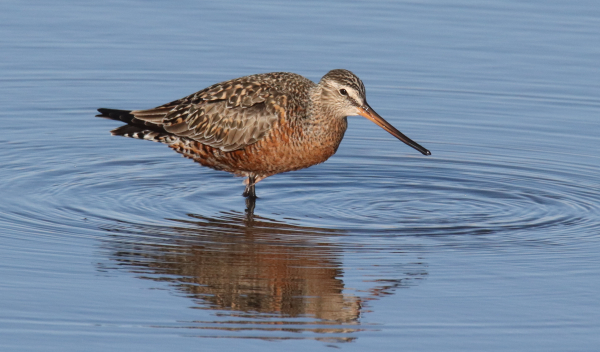
It was cloudy, cold, and very windy Friday, so I made the most of my office time, but when the sun acted like it was going to break through for more than 5 minutes about 5 o’clock, I decided it was my best chance to check on the birds of the day beyond my windows. The sun was showing to the north, so I drove that-a-way and at the 2-mile bay I saw there were godwits on hand again, along with avocets, so with a few more minutes of sun on hand, I pulled over on the extra-broad shoulder with the hope of taking a photo or 2. I zoomed my camera lens along the line of Marbled Godwits, counting them as I did, but when I reached the last godwit it seemed to have a reddish hue on its breast and belly, much darker than the Marbled Godwits.
Could this be an early Hudsonian Godwit? What else could it be? Now I was excited! Could I get a photo of the impressive bird that likely just arrived on its most recent migration leg that began from a coastal marsh of Argentina or Uruguay! I took a couple documentary photographs, then hoped the godwit would reposition a little closer before the clouds enveloped the sun again. It slowly made its way northward near the far shoreline, closer with every step though. I managed a couple potentially nice photographs before the clouds did blot out the sun, and that’s about the time the colorful male Hudsonian Godwit reached a godwit its own size, but resembling Marbled Godwits more than the ruddy Hudsonian. Indeed, this was a female Hudsonian Godwit now that I saw the tell-tail rufous feathers near its vent – nice, welcome girl.
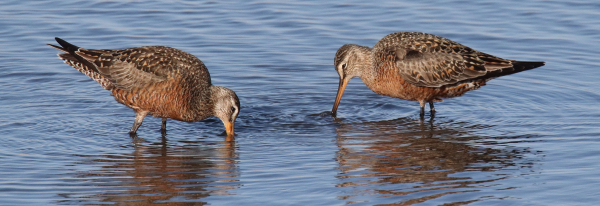
I stayed to observe the shorebirds on hand and wished for the sun to reappear clear of the clouds, but that didn’t happen, although I did get sharp images of the female in less than full sunlight. The big question was: Would the Hudsonians stay a while before the next migration leg toward the Arctic? Saturday was forecast to be a perfect sunny day with light wind, and I already had a plan to head 90 miles northwest to Long Lake National Wildlife Refuge to see what shorebirds and waterfowl were on hand there and at all points between home and the refuge. That plan might be postponed if the Argentinian sandpipers stayed.
After reviewing my photos on my laptop, I had a nice portrait photo of the male and female, which gave me a little thrill. Just seeing Hudsonians is never a given, and I think I’ve only seen them 3 springs out of 9 I’ve been here since returning from southern California. I promptly emailed the photos to Kristine with the message: “Ya, but do you have Hudsonian Godwits?” (Knowing that they would not, even though Arcada Marsh and other wetlands and beaches in the area have an impressive variety and numbers of shorebirds now.) Although I was kidding with Kristine, I also knew she would share my photos with others at the festival.
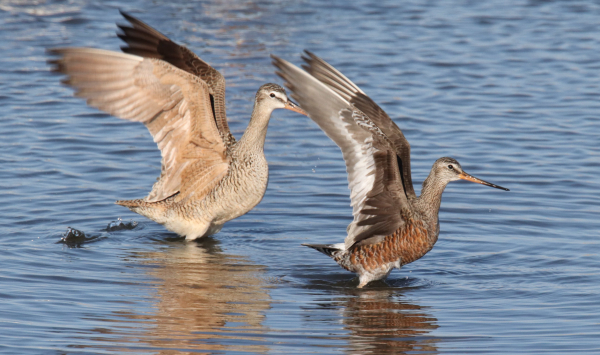
The next morning I headed directly for Bobby’s bay to see if the Hudsonian Godwits were feeding there again. There were definitely some godwits on hand in the shallow bay, but I could only see silhouettes until I stopped. The problem was that the morning sunlight came from the east, so now I would need to wait for a late afternoon photo session – if the Hudsonians were present. But even before checking the silhouetted godwits, I saw there were Marbled Godwits in the shallow marsh on the other side of road – they were bathed in full morning sunlight from my vantage point. There was also a flock of medium-sized sandpipers bunched together on the far shore – the first dowitchers maybe?
Nope, they were Hudsonian Godwits, 14 of them, a few with rufous undersides. I didn’t even have a chance to raise my camera to the car window before the Hudsonians took flight as one, crossing the road behind me and landing on the silhouette side of the road. That was OK though; at least there were Hudsonians on hand – and lots of them! In fact, there were 10 more feeding among the Marbled Godwits in Bobby’s little bay that made the total 24 Hudsonian Godwits! Well, at least 14 of the 24 were pretty wary, so I didn’t want to disturb them. I’d be back about 4pm to photograph.

Photographed as it returned from a circling alarm flight with other shorebirds, this male Hudsonian Godwit provided a prized sharp flight photo that shows the black and white pattern of its tail and wing feathers (600mm zoom lens, f-8 aperture, 1/2500 shutter speed, 800 ISO).
|
The Wait & The Payoff
I headed back to the office, not convinced I could wait until 4pm to check back on the godwits at Bobby’s bay, but it was relatively easy, and when I reached the shallow wetland I hoped the birds wouldn’t react to my approach. They didn’t flinch, and I settled in for some “mobile blind” time; waiting in the comfort of my car, resting my camera lens on the open window frame, holding my breath when taking each photo, hoping the birds would approach my position, and waiting for action beyond their simple, incessant probing as they were feeding. Rarely did any of the Hudsonian Godwits lift their heads from the water, except to swallow, which took little more than a second.
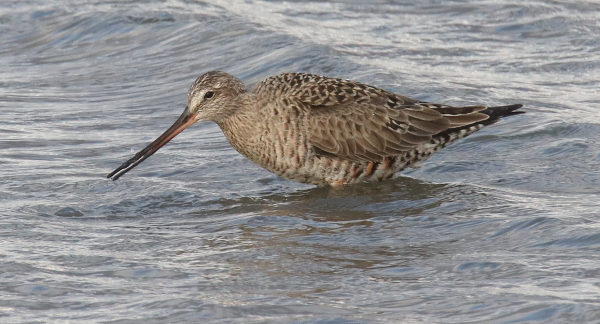
The longer I waited, the better the sunlight became, and the more the breeze calmed. Eventually the water calmed and reflected the clear sky, creating the most beautiful blue hue on the surface. About 6pm everything came together to provide the best photo ops, when the godwits came closest – about 60 feet away – both Hudsonian and Marbled Godwits. And that’s when they became a bit more animated, wading along the shallows, stopping to preen, and taking in their surroundings for a few brief moments, then back to feeding. To utilize the “mobile blind” advantage, I did move my car backward several feet a couple times to get a better position when birds moved, but they were very trusting of my white mobile blind during the afternoon photo session.
Even so, during my observations all the shorebirds would periodically take flight after a Marbled Godwit alarm call sounded, seemingly in response to a passing raptor, although it’s hard to say because shorebirds tend to flush and reposition as if to break up long feeding periods. Regardless of why they flushed, I took advantage of the godwit flights, usually a simple circular flight, sometimes extending for a couple revolutions, photographing Hudsonians as they were taking flight and landing to get a few action images. Although I had a fairly wide aperture setting (f-8) during most of this extended photo period, the corresponding shutter speed was plenty fast to stop most motion in the wings. In some cases, the ends of the primaries showed some blurring, but that merely shows some wing action, which can actually be a bit of an advantage to an image.
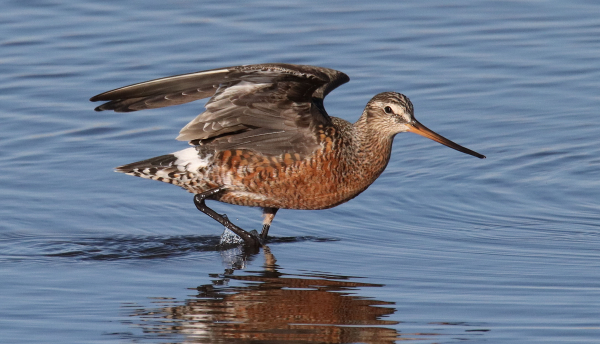
During the 3 hours I spent observing and photographing from my mobile blind, I was literally surrounded by a variety of birds, and it was interesting to see different species and individuals come and go while the Hudsonian Godwits were completely focused on feeding. In addition to the 6 male Hudsonian Godwits, other shorebirds included 16 Marbled Godwits, 3 Willets, 20 American Avocets that occasionally fed as a single shoulder-to-shoulder flock, 18 Baird’s Sandpipers, a few Lesser Yellowlegs, fewer Greater Yellowlegs, and a few Killdeer including a mating pair. Other birds included 2 Bonaparte’s Gulls, 2 Ring-billed Gulls, Yellow-headed Blackbirds, Red-winged Blackbirds, Mallards, Northern Shovelers, Green-winged Teal, Blue-winged Teal, and Gadwalls; plus a flock of about 40 Snow Geese flew overhead, and a flock of about 25 White-fronted Geese passed by, as did a couple Double-crested Cormorants.
I didn’t see any raptors, but a Turkey Vulture circled low a couple times. After an aerial look at the bay, it landed on an extended open shore across the bay. That was especially interesting to me because I would have expected the shorebirds and ducks to react to the vulture, which suggested they identified this raptor-looking vulture as a non-predator that didn’t pose a threat - hmm. Of course I photographed other birds when they presented themselves or were doing something special – like when the avocets fed communally, even swimming in deeper water shoulder-to-shoulder – making my photo blind time ever-more productive and enchanting.
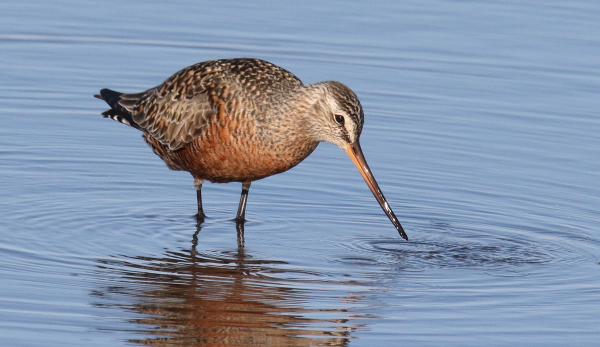
The next morning there were no godwits in the bay, only 2 pairs of American Avocets. The evening before a strong south wind developed and probably created a good migration opportunity. I verified that on BirdCast, which showed there was a big migration push overnight on April 19th in the Central Flyway from Nebraska to Canada. When I checked back at 5pm, during the prime sunlight period there were 4 Marbled Godwits, 7 American Avocets, a couple Baird’s Sandpipers, and representatives of the 2 teal species, but the magic birds were notably absent.
Nonetheless, gosh did I have fun observing and photographing Hudsonian Godwits while they visited my neighborhood! The moral of this story is to spend some extra time, maybe hours, when you get the next big break to photograph birds, whether it’s a rare species, a new species, or an especially trusting bird you’ve been interested in photographing. Best of all, spend that extra time at a favorite location, or at a position where a variety of birds come and go and act as if you are a fly on the wall, or a birder in a white car. Good Luck!
Article and Photographs by Paul Konrad
Share your bird photos and birding experiences at editorstbw2@gmail.com